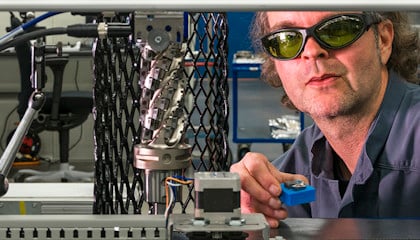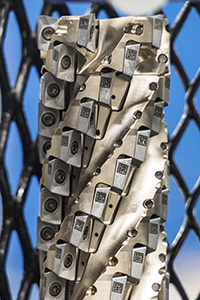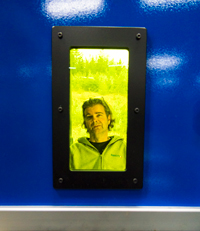The Matrix 4.0

What could be mistaken for a creation of a mad scientist is actually an industry game changer. At the Sandvik company Seco, the application of data matrix codes on its products is improving traceability and sustainability.
At the Seco Innovation Laboratory in Fagersta, Sweden, R&D technician Jan Gravningsbråten, could easily be mistaken for a mad scientist, surrounded by blinking red lasers, trays of inserts under observation, diagnostic equipment and countless other measuring devices, all in aid of his ongoing work with data matrix codes.
 “This is a game changer,” says Jan Gravningsbråten, head of R&D at Seco Tools. “It’s about optimizing the whole business.”
“This is a game changer,” says Jan Gravningsbråten, head of R&D at Seco Tools. “It’s about optimizing the whole business.”
Gravningsbråten’s current work came out of a “eureka” moment three years ago, when he had the idea that if data matrix codes could be laser-etched onto every single insert and holding tool produced by Seco – 50 million or so a year – the advantages for the business would be incalculable in terms of traceability and sustainability throughout a product’s entire life cycle. Fast-forward three years and his idea has become reality for Seco’s popular Turbo 16 family of square holder cutters.
In true R&D fashion
With the early support of Sina Vosough, Seco’s Vice President of R&D, who greenlighted Gravningsbråten’s idea, he and his colleague Micael Baudin set to work developing a patented printable data matrix code to apply to the Turbo 16 square holder cutters. Additionally, the team developed internal and external smartphone apps to read these codes.
We now have full traceability of each and every Turbo 16 piece.
Like the more familiar QR code, a data matrix is a square two-dimensional code that, once it is etched onto a free surface on an insert or holding tool, is easily read by lasers and smartphone cameras. Unlike more traditional bar codes, data matrix codes are more versatile and can contain more pertinent information about the specific part.
 Unlike more traditional bar codes, data matrix codes are more versatile and can contain more pertinent information about the specific part, in this case inserts.
Unlike more traditional bar codes, data matrix codes are more versatile and can contain more pertinent information about the specific part, in this case inserts.
Applying these codes onto inserts and tools was a trial-and-error process, Gravningsbråten admits, and he is careful not to reveal the now-patented “secret sauce” behind the process. But, he says, guaranteeing readability after normal wear and tear at a customer site was one of the challenges.
Gravningsbråten chose a series of 10 billion numbers to be represented by the codes. “That’s 120 years’ worth of production,” he says. Each number was assigned properties regarding material grades, which is important for recycling, as well as where, how and when the piece was manufactured.
Full traceability
As a demonstration Gravningsbråten opens the Seco “How R U” internal app on his smartphone. By scanning/photographing the data matrix code on an insert – some are only 1.2 millimeters wide – Gravningsbråten can retrieve CAD drawings of the piece and find out how much electricity was consumed during its production, its relevant CO2 emissions and even where in the sintering oven it was placed, as this plays a minuscule yet important role in the piece’s final performance.
The knowledge about each specific product is so detailed that customers can also access pertinent information for their own processes via the Seco Assistant app.
“We now have full traceability of each and every Turbo 16 piece in our production and throughout its life cycle,” says Gravningsbråten. “This was not the case before – quite the opposite, in fact.”
He explains that previously production was analyzed by the batch, and if there was something wrong, the whole batch would have to be scrapped, wasting valuable resources along the way.
But we now have the tools to fully engage in this circular economy
“We had no idea,” says Gravningsbråten, who estimates that a lot of a lot of resources are now saved in the production process each year because of the full traceability the data matrix codes offer. “In other words,” he says, “a production failure can now be rooted out at the individual level and this data can be fed back into the R&D process.”
Industry 4.0
 R&D technician Jan Gravningsbråten
R&D technician Jan Gravningsbråten
The Seco team is currently considering a number of other improvements, such as the recycling of inserts. With the help of these data matrix codes, inserts and their different metal compounds can be quickly sorted into respective types – chrome, titanium, cobalt, carbides and so on – just by scanning the codes.
“Like a coin separation machine at a bank, this process was not cost-effective previously,” says Gravningsbråten. “But we now have the tools to fully engage in this circular economy, and with all this traceability we are now uniquely poised to engage in what people are calling Industry 4.0. The next step is to roll it out to other product families.”